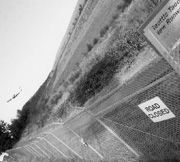AT A MEETING OCTOBER 4, it looked as though the two-year war between the Port of Seattle and the state Department of Ecology might be over. Port planners acknowledged their failure to answer important questions about plans for a third runway for Sea-Tac International Airport. Ecology staff went out of the way to praise the Port’s effort to meet environmental requirements and predicted that a runway construction permit might well be issued by mid-December if all went well.
However, at another meeting only six days later, hostilities broke out again on another front. At issue was Port compliance with the state’s Model Toxics Control Act as it applies to the 20 million tons of fill the Port needs to build the third runway. What constitutes “clean fill” under the MTCA depends a lot on the use the future filled area will be put to: residential, commercial, industrial, etc. And because the third runway directly abuts a sensitive stream and wetland environment, fill of industrial standard might well be insufficient to prevent irreparable damage to downstream communities.
The Port claims that Ecology staff has already approved the grade of fill it’s been stockpiling toward third-runway construction. But Sea-Tac environmental planner Paul Agid admitted his office had nothing in writing to back up that claim. In any case, said Ecology reps, whatever verbal assurances the Port thinks it’s been given, a commitment isn’t a commitment until it’s in writing: Let’s talk.
The distinction is of enormous import to the third-runway project, because much of the fill already purchased by the Port has been salvaged from construction in existing heavy-industry locations such as dredging for the new First Avenue South drawbridge over the Duwamish West Waterway. If traces of heavy metals, PCBs, and dioxins are judged impermissible adjuncts to third-runway fill, the Port will have to spend a lot more than it had planned to on more distant (and expensive) sources, not to mention finding a home for a few million tons of dirt it already owns but can’t use.
One time-honored method of dealing with regulatory standards you can’t (or don’t want to) meet is to change the regulators enforcing them. Sea-Tac environmental chief Elizabeth Leavitt has already met with Ecology director Tom Fitzsimmons to discuss replacing his in-house toxic waste team with outside consultants to establish toxic waste standards for the third runway.
An outside team wouldn’t necessarily come up with more Port-friendly recommendations than Ecology’s experts, though as the party in a hurry, the Port would presumably be paying for the study. Meanwhile, runway opponents see no reason the Port should be granted a fresh deal with a new deck just because it finds it’s holding a losing hand.








